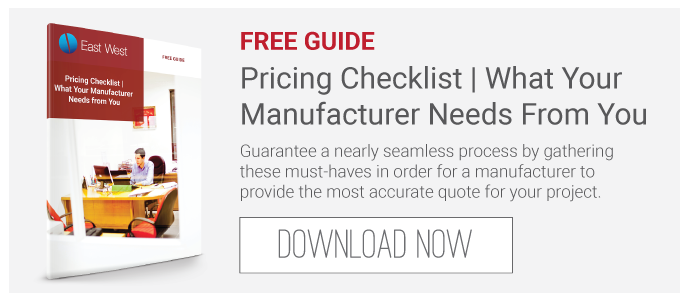You make a product in China. You went it alone. You found someone on the internet and they promised they could manufacture your product to your standards in the time required for the lowest price.
Unfortunately, they also made an absolute hash of it.

If that wasn’t bad enough, you spent so much time on the phone sorting out quality issues and shipping problems that the “low cost” of the product skyrocketed because of the extra costs of fixing the quality problems (which were stopgap at best) and air freighting your product to customers (an unsustainable solution).
You’ve run into a perfect example of what happens when the lowest cost is the ultimate goal rather than looking at the whole picture.
As you probably guessed, we certainly aren’t bashing sourcing from China or anywhere overseas. There are great, quality manufacturers and suppliers to be found in China, Vietnam, India and elsewhere. We are, however, believers in approaching sourcing decisions, whether overseas or domestically, from a total cost of ownership (TCO) point of view. Properly used, TCO is a tool that can serve as a vital layer in the decision-making filter of choosing a contract manufacturer or supplier.
What is Total Cost of Ownership (TCO)?
TCO is an analysis that places a single value on the complete lifecycle of a capital purchase. This value includes acquisition, operation and personnel costs. To get a better look at these three factors, take a look at this article by Purchasing & Procurement Center.
Price is something that’s fixed. It’s negotiated and includes raw material, manufacturing, mark-ups, logistics for shipping, the whole ball of wax.
Total cost of ownership, by comparison, is what it really costs the company that uses that part.
Questions When Considering Actual Cost of a Part
- If there are quality issues with the manufacturing of a part, what is the effect on their production line?
- Do they have to shut down production?
- Will they have to expedite shipments to customers?
- How much time did they spend working through the quality issue with their supplier? Were there extra costs associated with that?
- Did they have to travel to see their supplier?
- What if the part is late? How does that affect their production?
- Do they need to pay their workers overtime to catch up on production?
In almost every case to the questions above, the answer includes an increased cost of time or money and under TCO that increase is folded into the price of the part.
Think about it: if you’re using a contract manufacturer that has provided a quality plan, those quality inspections are built into the price that was quoted. The same thing is true for engineering support or design help, if you’re using a CM with a design services firm.
But if you’re buying directly from China, or using a broker in China, those quality inspections aren’t part of the unit cost. You’ll have to find someone who will handle the quality inspections for you, and that cost is now something you pay for. The same is true for engineering, logistics, shipping, etc.
That’s the difference — the amount you’re paying in a purchase order to a company versus the total impact on your financials, including the dollar value of your people’s time and the opportunity costs associated with that.
For example, if you go to a less reliable supplier, you may end up having more quality issues. Many customers end up with contract manufacturers because their supplier wasn’t meeting the demand on time. The unit cost might be the same, or even less than the CM, but the TCO is higher because they’re spending time dealing with quality issues, dealing with shipments, expediting, trying to be nice to their customers as they help them through these issues. They go to the contract manufacturer and say, “We want a higher quality supplier, or a more reliable supplier for delivery so we don’t have to put in all this extra money and effort.”
You know, it's very easy to open up a spreadsheet and type in a list of variables across the top, a list of suppliers down the side, numbers in the cells and make a judgment based on numbers. Some would argue that those decisions are easy to make. But it's a mistake to make a decision strictly on cost.

Making a Decision Based on
Total Cost of Ownership Factors
When it's time to figure out who you're going to partner with to make your product, we recommend considering these factors which can often greatly influence the eventual cost of making your product.
SUPPORT | Can your contract manufacturer offer design and/or engineering support early in your product's development? Early engineering intervention is a proven way to shorten the product development timeline. Use a contract manufacturer that can offer early DFM assistance.
QUALITY | Does your contract manufacturer have a proven quality track record? If you don't know, ask them! They should be proud to share their quality plan.
DISTRIBUTION | What about distribution and logistics? Can you find a contract manufacturer that can handle shipping the products for you? And can they handle the delays that are bound to occur when crazy things happen like when a major shipper gets hacked (like Maersk did in 2017) or goes bankrupt (like Hanjin did in 2016).
EXECUTION | That leads into the next item, execution. What you're looking for is a company that can "stick the landing" over and over again. It's not too much to expect that a company manufacture a consistent product and get it to you on time.
FLEXIBILITY | In a global economy it's incredibly important to be able to move quickly, to be responsive to changing policy, markets and other financial influences. Using a contract manufacturer with diverse facilities in multiple verticals is just smart business.
There are other factors to consider that will feed into the total cost of ownership. The idea is to look for the obvious costs and the hidden costs, compare the two and make an informed decision based on all the facts.
That’s the total cost of ownership difference.




.jpg?width=176&height=56&name=MR_associatedNetwork_logo%20(1).jpg)